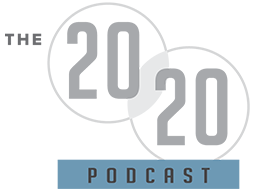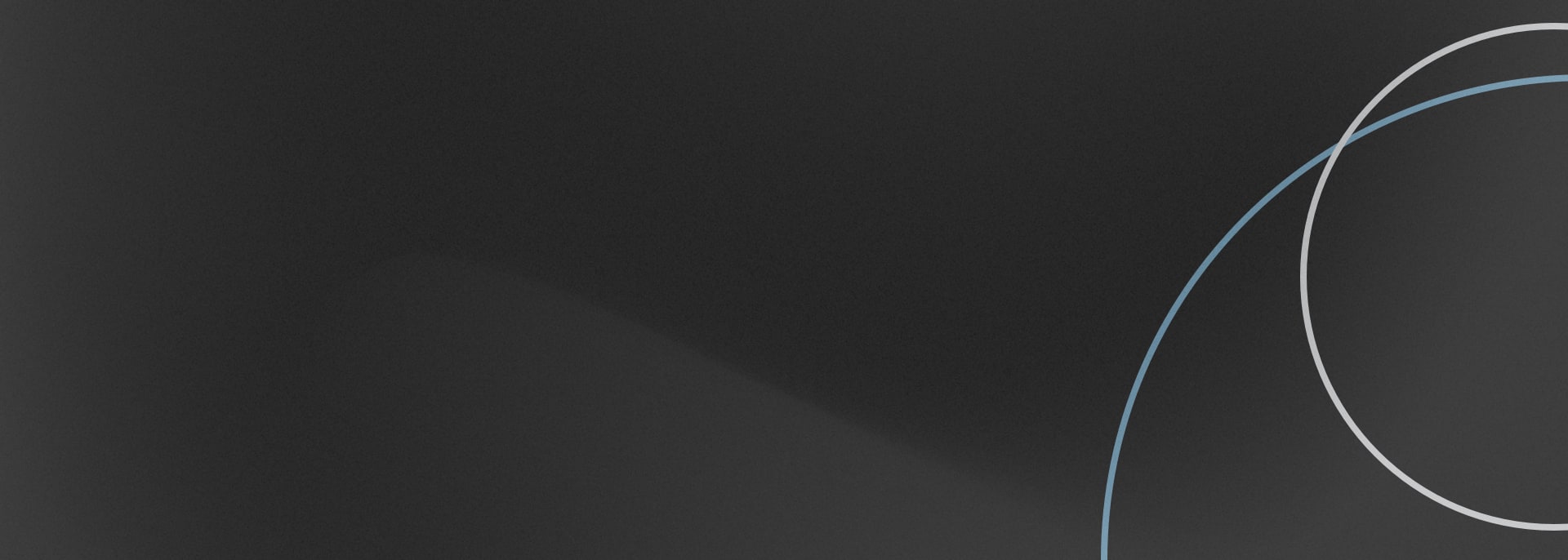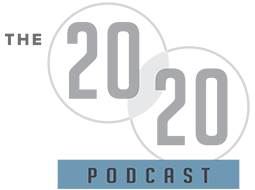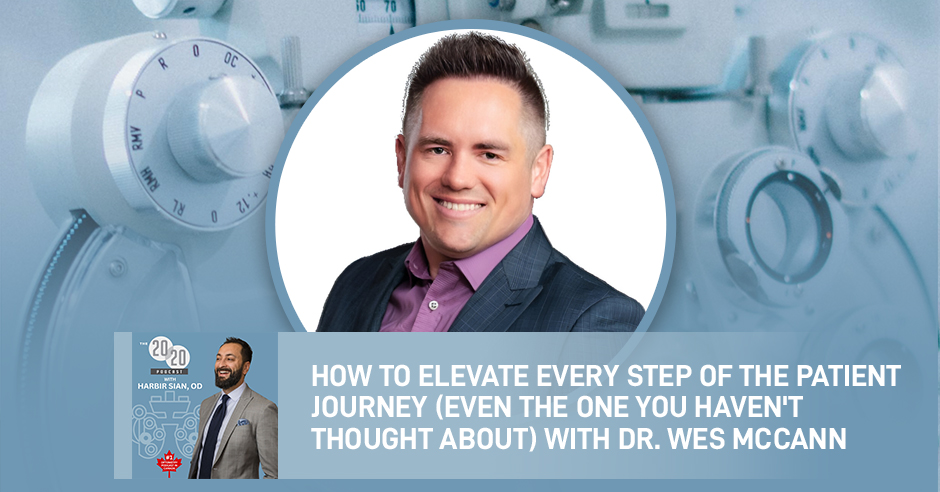
Elevating the patient journey is about more than just good care — it’s about crafting a seamless experience from the first online search to post-visit follow-up. Dr. Wes McCann, owner of Doctors Vision Group, shares practical strategies for optimizing every touchpoint in an optometry practice, from streamlining intake and cross-training staff to refining handovers between doctors and opticians. With insights on marketing, clinic flow, patient communication, and even community engagement, he reveals how intentional design of the patient journey can reduce bottlenecks, increase efficiency, and build stronger patient relationships. This conversation offers a roadmap for practitioners ready to transform patient care into a complete, memorable experience.
Connect with Harbir:
—
Watch the episode here
Listen to the podcast here
How To Elevate Every Step Of The Patient Journey (Even The One You Haven’t Thought About) – Dr. Wes McCann
Crafting Your Clinic’s Online Presence: The Patient Journey Begins
Thank you so much as always for taking the time to join me here, as always, to learn, and to grow. I’m so grateful for all the support, the liking and sharing. As always, I have a request right off the top. If you do get some value from this, please do share it. Put a screenshot up on Instagram or put a link on LinkedIn or send it to a friend via text, whatever you can do to help share these important conversations that we’re having. This one’s going to be impactful.
If you’re a business owner or involved in a clinic and you want to help elevate the practice, this conversation is going to help take your clinic to the next level. We’re going to be talking about the patient journey. We talked about the importance of the patient journey as a business management type of a topic but I don’t think we go deep enough or delve into each aspect of that. My guest, Dr. Wes McCann is the perfect person to have that conversation.
If you don’t know him, Dr. McCann is the owner of Doctors Vision Group, which owns twelve practices in Ontario. He is a prolific speaker and a consultant. He was named Top 20 Under 40 recognized for their business achievements. I can go on. If you don’t know Wes, please look him up. He has a million accolades and they’re all very well deserved. As a business owner, he is one of the most prolific people that I’d love to bring on the show to talk about these different business management topics.
Wes, thanks for being here again. It’s awesome to have you back. It’s always nice to have you on the show. Before we dive in, I have to make sure I say a big thank you to CAO as well. We are here in Halifax. If you’re watching, you see this beautiful space. We’re here at the Halifax Convention Center for the CAO by Annual Congress. A big thank you to CAO for giving us the space and as always for helping the profession to continue to grow.
Also, a big thank you to a partner for this episode, Théa Pharma Canada. A huge thanks to Théa for just supporting personally, the podcast, our clinic, and the profession. Théa has always been so supportive. A big thanks to Théa and for supporting this episode with Wes as well. Now, Wes, first of all, I butchered your intro, so I’m sorry. Is there something that you think is important you want to share about yourself? Maybe a little bit of a self-intro that you want to share with the audience.
I’ve always been so fascinated with this profession. It is continuously evolving and exciting. I got into it only with the expectation of taking over my father-in-law’s practice and added a couple days in another practice within the first year just to fill my schedule. I was offered to purchase that practice at the time and then the practice got introduced to me and continued one after one, year after year and now we’re up to twelve. It’s been a lot of fun.
I feel like you’re gaining a lot of steam lately. The last couple of years, it’s been like hockey sticking with exponential growth.
It’s been exciting. It’s a lot of fun. My goal is always to make practices and continue to elevate them from where they already were to the next level as well and allow us to practice the full scope of optometry with the best team and best experience for patients, doctors, and everybody alike.
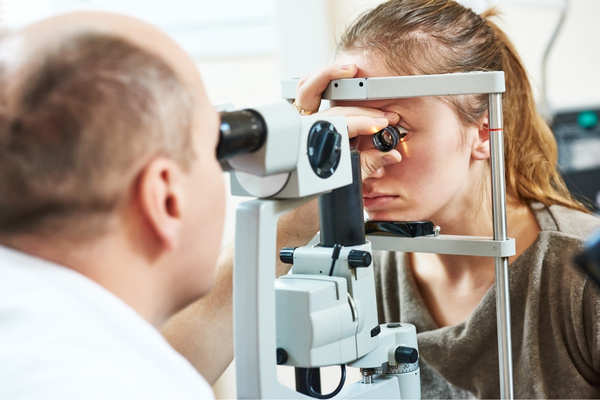
The Power Of Protocols: Scaling Your Practice With Efficiency
I just did an interview with Karen Ramesh. She’s stepping away from clinical care now and more managing. She’s also acquired a new practice and all this stuff. The key thing with her was the processes and the protocols. Once you get that down path, you can almost copy and paste and you’ve got it down to a T. You figured it out so well that you can acquire new practices multiple per year. Does it feel like that’s what you do? You’ve got your protocol so well set that you can basically copy and paste? Is that like 80% of it? Is it 90% of it?
I would say maybe it’s 75% to 80%. There’s always nuances to every practice, perhaps what scope they’re doing or what the doctors are interested in. The community might have different frame lines. They tend to do better than other ones. There’s certain things that have their own nuances to each practice, but I would say largely many of the procedures and policies that we have are very repeatable and we can copy them. We have an operations manual and flow document. We have all these policy manuals. A lot of those are very repeatable and some vendors.
The vendors we use for lenses are repeatable for our dry products like Théa, who’s our sponsor for this. They have great products and are excellent. That’s a very repeatable, easy option. There are things that they repeat, cut and paste, but there are certainly always nuances. As we’ve grown, we’ve grown our executive team and our administrative team to help assist that. For a while, I was doing probably three or four jobs, and grew a lot in 2024 and added more people to our executive team. That’s helped to further improve just our implementation of everything as well. That’s been great.
You can’t do the copy and paste unless you have a good system or systems. They have to be polished.
Also, constantly evolving too. Things change and practices change. The makeup of the practice can change. The patient demographics can change over time. Oftentimes, we’ve acquired practices with older patient demographics. As we have acquired those practices, certainly those practices grew with that doctor over time.
Once we grow, we acquire more patients that join the practice that are younger, more families, etc. How we’re approaching those patients would look a little different than perhaps a very senior population. It’s re-evaluating the practice all the time, each practice to see what it’s like and making sure you have those metrics in place to understand where you need to draw attention to.
Streamlining Intake: Eliminating Bottlenecks For A Seamless Experience
That’s a lot of practices to have to continue to oversee and evolve and all of that. That’s great. You have all your protocols and your systems well-polished and placed in these different clinics. A big part of that is the patient journey. As I was saying off the top, we always say, “The patient journey is important.” It’s important to evaluate your patient journey and make sure you’re doing a good job at each step of the way but I don’t think we dive into it deep enough. I want to get into that with you. We’ll go through all the steps that you see as the different steps of the patient journey. Where does the patient journey start for you?
The patient journey starts at trying to find an optometrist. If you’re trying to acquire a new patient, think about what your brand looks like and what the brand of your practice is. Whether it’s a solo individual practice or multiple practices. Is your brand consistent? On your social media, to your website, emails that you can communicate with your patients, is that brand consistent? Do you have a common theme in terms of your logo, your colors and your fonts? You want to make that polished look and polished appearance parent rate from the very beginning for those patients.
That’s an important component and finding whether you’re great at doing marketing yourself or you hire an external team to do your marketing. Looking at those groups or yourself in terms of what are your goals. Is it a new patient acquisition? Is it growing your own patient base and maybe more internal marketing? What are you looking at doing in that? Focusing on that is important and revisiting that as well because you may grow, add an associate and then you want to get more patients. You might be at capacity with your current patients. You can’t add any more associates, so you want to grow your own patient base and expand what they’re doing.
That outward-facing brand is important to start because the patient journey starts with them trying to find someone to go to and what’s attractive about you versus the other options that exist. If you’re in a rural Ontario City or town, there may not be many other options. If you’re in Downtown Toronto, there are many other options. How do you set yourself apart from that patient journey? It comes right down to how easy it is to book an appointment.
Can they book online? Do they have to send a request and wait for a response and get back to that way? Do they have to phone in? How are you communicating with your patients as well? Thinking about that patient journey and making it easy and the type of patients you want to attract as well. Are you attracting busy people that want to come in and get their eye exam, get their glasses, get everything done in one shot, and then leave? Are you attracting more of the senior population? What patient base are you going after as well?
All your marketing will be targeted towards that type of patient. Your ideal patient or the patient you expect to have come into your office. For the marketing side of things, your colors, your logo, and all of that consistency that you’re developing. You’re hiring somebody for that or is that something that somebody would do themselves? When you get to your size, I imagine somebody else is taking care of most of that for you.
We had a journey along the way. At the very beginning, I did it myself and then I learned a lot. I don’t do accounting myself anymore. I’m not an expert at that, so I outsource that. I even started outsourcing marketing when we were only two practices. We’re experts at what we do. We can dabble in other things but if you want to try to grow and create that brand. You need to look for a good partner that will help you do that as well and is an expert on the subject.
If you really want to grow and create that brand, you need to look for a good partner who is an expert on the subject and will help you do that.
Step one or the beginning, this is a cycle, this patient journey now. The entry point is they’re searching for somebody online and they come across your clinic. They like the aesthetic and that it’s easy to book. They click and they find a link. You have openings, hopefully, when they’re looking to come in great. What’s the next step? I don’t want to say what the next step is. I’m going to leave it to you. Let’s say they booked an appointment.
Your communication. A reminder of how easy it is, so new patients. Can they fill all their paperwork before coming to the office, or do they have to wait to get there, sit in the waiting room, and fill out traditionally on a piece of paper? That was a big streamlined approach that we took in terms of getting and taking forms completed ahead of time. That a patient could complete all that. They could arrive at the office. Even a brand-new patient would check in and then go straight into pre-test. It removed a bottleneck that we oftentimes had.
If a patient takes 20 minutes or 10 minutes to fill out paperwork, that puts that patient 20 minutes or 10 minutes behind, which then creates a ripple effect for the rest of the day. We started requiring paperwork to be completed 72 hours before an appointment. When we started doing that, it drastically reduced our no-show rate and such. We started seeing, especially in a certain patient demographic age group. Patients were booking appointments and now showing, especially these new patients.
We implemented a call center at our head office Downtown in London. When we implemented that, we started realizing some of these patients were calling three or four practices booking appointments and then not canceling any of them, and just keeping the one that was the soonest. Our call center, sometimes the same person, would answer the phone for the same patient four times at three different practices in our city, and then realize this was becoming a problem. We implemented that policy and it’s been wonderful for our no-show rate. Our no-show rate dropped from 8% or 9% to 2%.
That’s a huge reduction. That’s an interesting point that you made on that no-show thing, though. Somebody else has explained this to me a while back. We do similar things when we’re trying to get into a restaurant. We’re looking around who’s got reservations. Now, you can go online like, “I’ll book a table here. It’s not the ideal time. It’s a bit too late. Let me see if I can get something at 7:00 PM instead of 8:30 or whatever.”
I try to be conscious and courteous enough to call or cancel via email or whatever. let’s just give them the benefit of the doubt. I know a lot of people are just too busy and they forget. That happens a lot. When you essentially force somebody to fill out this paperwork, you’re getting more of a commitment from them.
Correct. It’s because they take the time to fill out their intake form. They’re more likely to be coming to their appointment. There’s an exception to every rule. You’re going to have your senior patient population that may not want to fill out that paperwork ahead of time and that’s okay. We make a note, but the large rule is that it has to be filled out 72 hours before.
What’s the next step?
Beyond The Waiting Room: Optimizing The In-Clinic Patient Experience
The patient arrives. Take a moment as a patient to walk through your clinic as well to see what they see when they walk in. Where they’re parking, what’s the front desk and what are your bathrooms like. All those things to think about because those are all part of the patient experience. Take a step back to see what the patient’s going to see and then we’re going to go through that experience. They do their check-in so they have a warm welcome. If they’ve completed their paperwork ahead of time, then they move right into pre-test and there’s no more bottleneck.
We’re always evaluating every step of the patient journey for bottlenecks as well. The bottlenecks will change the efficiency of the patient experience and the patient journey. We want to eliminate all those as much as we can. The patient goes into pre-test. Our technicians are all trained, cross-trained at the front desk and in pre-test fields, OCTs and everything. They can do anything. If someone calls in sick, there’s not a bottleneck.
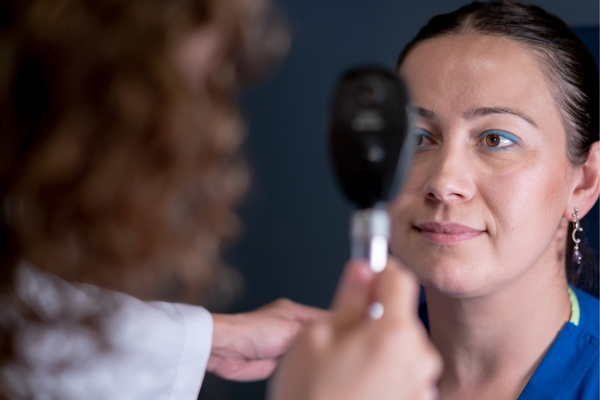
Again, we don’t have just a front desk person. Everybody can sit down and do that, but everyone has their side tasks. Patient journey again, check in, pre-test, technician will take them into pre-test and technician will bring them back to an exam room. They’ll do their case history, medications, television and stereo on our new patients or kids. They will set up and get the patient ready for us to come in.
I like that. The technicians doing all of those things that you just mentioned case history, cover test, did you say as well?
Medication. We do neural lenses so that it takes care of it when it comes up. It’s the headset in the exam room and then medications, color vision stereo and they will set up the fraptor. We walk in and are ready to review and reflect.
Case history is a nice one because that does take up a fair bit of our time when you’re having that initial case history conversation. If the technicians already done that, then that streamlines the process even more. During the pre-test, do you have the technicians asking specific questions? I’ve heard some people suggest that’s a good time to prime the patient for certain things, whether it’s certain types of glasses, sunglasses or a dry eye.
They have a list of questions they go through. Did you bring your sunglasses? Are they polarized? Are they prescriptions? Do you wear contacts? Other questions that they asked routinely. What macular supplements are you taking? What your eye vitamins are you taking? Did you bring your office lenses? in that age group.
Some of it is like triggering. The patient might say, “What’s an office lens?” At least, it’s planted that seed now as something. Are they doing that during pre-test or that’s during the case history part of it?
It was during the case history in the exam room. We all work at multiple exam rooms because, again, it’s a more efficient way for us to operate. Every exam room is the same. We don’t have our dedicated rooms because when the patient arrives, they go to pre-test. They’re in and out of pre-test as quickly as possible so it opens up for the next patient and they move to the next exam. We will have, at our downtown practice, 3 to 4 doctors in a day. You’re going to be out of that pre-test quickly so that it’s ready for the next patient to come through. We will eventually get to a point where we have a second pre-test.
Still able to function with one pre-test given that number. That’s very efficient.
Their goal time is to be done in pre-test in under five minutes.
I’ve seen situations or practices where you get to that number of doctors working at the same time, three or four, and they basically have to have two pre-test rooms. The fact that you’re still able to do that means that you’re doing it in a very efficient way.
We have target times and we have a flowchart we’ve created for patient experience as well. When a patient’s booked with this, then this is the flowchart you follow for a glaucoma patient for example or a kid myopia management or an AMD patient. All of those have different flow charts and how they’re booked will make a difference as well.
For example, if we have glaucoma patients routinely seen every year. They will come in and they will be dilated in pre-test. The technicians will look at their angles from the year before, if they were dilated the year before or any major medical changes or changes in medication or changes in pressure. If everything seems the same, then they’ll dilate those patients for us and then they move right into the visual field into pre-test into retinol photos. They’ll go into the room to do a workout.
If there’s a bottleneck at any of those stations, then they know, “If there’s a bottleneck in pre-test, I’ll go to my work first and then I’ll go back and do pre-test or I’ll move to visual fields and then go back to pre-test.” They know if there’s a bottleneck somewhere where they can flex, basically and not disrupt the patient journey.
Doctor-Optician Handoff: Enhancing Communication And Patient Education
That’s great. The tech is done and the history. They’ve done some of those entrance tests. Now, doctors are coming into the room. Is that the next step?
The next step, the doctor comes into the room. They’ll do their review chat with patients. They’ll do their fraction anterior sag and then dilate the patient and do their counseling for a refraction and anterior segment component. We found if we left all that till the end, it’s too much for the patient to process all at once. We like to do anterior sag. We’ll talk about dry eye disease, any refractive challenges or changes, BV issues and then dilate the patient and send them out to the dispensary. They’ve got twenty minutes to dilate while they browse their glasses and we’ll do our hand over to our optical team members.
If you can do within your EMR or it can get a little tear away pads that you can circle quickly what your recommendations are, and we’ll do an in-person hand over to the dispensary. In one of our offices, we use watches. We’ll page them on the watch and then they’ll come to our exam room and we can do the exam or handover right there.
You got a bit of a pager system there. I wanted to ask you about the handover part. You shared a couple of different things. You can have the optician come to the room or you go out to the optical and do the handoff there. Have you found one is better than the other?
I would say they’re both equally effective. The challenge with walking to the dispensary is if you can’t find someone, then you’re searching for someone. That’s not as efficient for me. I find the best way of doing it is an exam room with the paging system because it will tell me who’s coming with the system and then they can arrive. I can finish my spiel and once they hit accept, I know I have about ten seconds until they’ll be door, so then I can finish my spiel. I’m pretty much wrapping up as they knock on the door and then I do my handover right there.
Can you share what system you used as a pager?
We used Listo. It’s a system of the US. In every exam room we can have a specific dashboard where we can page Opticians or Oas or anybody in the clinic or a front desk. Everybody’s wearing a watch. Unfortunately, they can’t use their own watch. It’s a specific watch, but it’s worked well for us.
That’s cool. What’s next to handover?
I move on to the next room. For me, I work on twenty-minute exams, but again, I have an established patient base, largely, and my technicians do a lot. We dilate everybody’s still over the age of twenty. There’s some people that dilate less and some people that dilate everybody. I still find to get the best lenticular view or any problems like that then dilation is definitely key. Maybe you can get a good retinol photo for sure but there’s lots that you don’t see if you don’t dilate. We still dilate everybody, but dilation gives me a chance to move them onto the optical.
They can work with the opticians there and then I can move on to the next room whose been worked up or it might be my post DFE patient. I could probably work in three rooms efficiently on that twenty-minute schedule. Many of my other ODs will work out of two because you’re on a half-hour schedule or fifteen minutes for kids in partials. That’s worked well for them. We could have two people going to five exam rooms at a time, or if I’m not in, then we use all six exam lanes for three.
Now, the patients come out to the optical. Let’s say you did the handover there in the optical. Is there a certain script now that your staff have to introduce to the optical to the glasses purchasing experience?
Usually, I’ll introduce the patient to the optician and give it background on what my recommendations are. Mrs. Jones is here. Her glasses are a couple of years old. I like to write on the handover sheet if I can see what the frame brand is and the lens pal markings. I’ll try to write that on the sheet for them and how old the glasses are roughly. If there’s a problem, scratch craze, or our exchange.
Again, they probably get some more information from me, but I’ll do the in-person handover explaining, “This is Mrs. Jones. She’s had a little bit of a prescription change. She’s going to need an update on her everyday progressive or single vision distance,” depending on their age and I’ll always recommend a second pair. Whether it be sun, office lens, transitions, and clear. There’s always an opportunity for a second pair. I’m always recommending two or three.
If you’d recommend three, maybe they’ll end up doing two and then coming back for that third one later. Educating them on all the options and maybe the two that I thought they would pick, they don’t pick and they pick two differences like office and home for every day as opposed to sun and every day. Recommend what you think is best for the patient. Recommend that in front of your optician and then say, “I’m going to let you work with Mrs. Jones for about twenty minutes. Mrs. Jones, one of the techs will grab you in about twenty minutes to take some photos once you’re all done. You’ve got some time to hang out here with Chris or whoever the optician is.”
That’s important there. With the handover, you’re sharing whatever recommendation you’ve already made in the exam room. Before you came out, now you repeat that in front of this patient and the staff so everybody’s on the same page and they take it from there.
I like to call it also a complimentary lens consultation as well. If you say that, the patient feels like they’re getting something out of it as well. They want to hear about what they are being counseled on because a lot of the time they don’t know what technology goes into glasses. It gives them the opportunity to sit down and understand more about the differences.
Post-Visit Engagement: Maintaining Patient Relationships Year-Round
I’ve heard somebody else call it something similar like a frame. Basically, frame consultation or styling consultation. I like that. It elevates the sound of it, the experience for sure. If we’re talking about the patient experience, the patient journey and elevating at different steps using the right terminology or certain phrases. It will elevate in the patient’s mind, take it away from becoming just a commodity or commoditized boring process. Now, it’s like, “Consultation, this is different.” After the optical, they come back into the room for a DFE. Let’s talk about after the DFEs are done. After the eye exam is complete.
The patient will go check out the front desk. If we had any dry eye recommendations, we’d put them on our tear away pad with exactly what those recommendations are. I don’t hand it to the patient because the patient will put it in a purse or in their pocket and then the front desk doesn’t know what I recommended, etc. I always either hand it to the optician if I’m doing the handover to them or the front desk and they’ll get the products ready for the patient and then go over those products, when to use them, and why.
That’s an important part of the patient journey, too. A dry eye recommendation. You have a tear-off pad. You’re writing those down, “Here’s a recommendation.” I make the mistake of like, “Here you go, Mr. Smith.” It’s, let’s go to the front and hand it to my staff. Now they know what I wrote down and if you’re recommending certain products, the staff will then bring those out.
They will put them right on top of the sheet at the front desk. They may have three patients lined up with their products on top of those sheets. When they go to check out at the front desk, whoever is at the front desk, knows how to consult the patient on what those products are.
What’s next?
A patient goes home and it’s so important that we stay in contact with that patient throughout the year. Let’s say they come in once a year or once every two years. What are your touch points throughout the year? Certainly, being active on social media can be one, but you’re not necessarily always going to be top of mind doing that. We’ve initiated email marketing to our patients as well. In that email marketing, once a month, they’ll get a health tip or something. It could be a glasses frame line that we’re focusing on. That will be in part of the email and perhaps a promotion or something in the second half of the email that will also go to the patient.
When a patient goes home, it’s so important that we stay in contact with them throughout the year.
That’s elevated our interactions with patients throughout the year because we have a great conversion rate and acceptance rate on those. Again, depending on the type of patient it is. If it’s a family age patient, perhaps it’s a parent or a child. They’ll get some email marketing on myopia management so that if they do have a child, they will be able to have a, what is myopia? What are the options for managing it? Why is it important? We focus on ortho on the third email in that email stream for those patients. Dry eye patients are 35 to 70. We have that email thread that goes out as well.
It’s very targeted for different age demographics.
Our senior population is on AMD. Anybody who’s 60-plus has an AMD thread. The same three emails that focus on different components of the disease process or what we want to focus on to educate the patient, prime them. When they do come in, there’s less of a conversation about technology and why it’s important, etc.
Those targeted emails that you just mentioned, the parent with the child or whatever the adult or the senior. Is that separate from the monthly newsletter-type of emails that you have? You have a monthly newsletter with a little tip or whatever, every month. In addition, you have these different streams. How often do you send out that sequence of three emails?
When they come in for their exam, about two months after their exam, they’ll get their first one, and about three or four months after that, they’ll get their next one. About four months to five months after that, they’ll get their next one. We have that cadence of emails going out throughout the year. They will get one month and they’ll get one month that has an additional email.
There’s like fifteen emails a year. Is that too many? Do you feel like people get annoyed with that?
Our conversion rate has been great. Our uptake rate has been much higher than industry norms. We don’t have a high-end subscribe rate either, so I don’t think overall.
Overall, it seems like it’s working.
It’s working but that’s what I had mentioned at the beginning, is always reevaluated and always can continue to look at your metrics to see, do we need to pivot on our strategy? Do we need to change how we’re engaging in patient emails? We become less and perhaps utilized by a younger generation. Are you active on social media and trying to meet them where they want to be met as well?
We went from they found you online, they booked, they came to the online forum, beforehand they came in, streamlined the pre-testing, the tech does entrance tests and things like that, then you do the handover to the staff. You have your tear-off pad for the dry eye stuff for the front desk. Now they’ve left and you have continued communication throughout the year to remind them that you’re still there as their eye care provider and they know where to go. What else is happening there?
Intentional Scheduling: Maximizing Efficiency For Staff And Patients
Scheduling is an important part of processes that we didn’t touch on yet. It dictates some of the patient flow and patient journey as well. If they’re a medical patient, let’s say, a diabetic, glaucoma patient, etc. We will tend to pre-book those patients annually so they’re pre-booked with all the testing that they need done.
If let’s say it’s a glaucoma patient or glaucoma suspect. We’re pre-booking them a year ahead of my schedule at 3:00. If they need to fill an OCT, they’ll be pre-booked on the OA schedule at 2:30 so that they have half an hour on the OA schedule to get all that additional testing done before they hit my schedule. I’m not waiting for the patient. They hit my chair on time so that I can stay on time and I keep all of my patients on time.
The last time you’re on the show we showed briefly your calendar. You’re OCD, young, and I’m saying that in the kindest way possible, but you’re very intentional about how you schedule your whole life but scheduling patients. I have only started to become more intentional with our work schedule because of this hazard scheduling, then you’re like, “We got a random little gap here,” or certain types of patients are not scheduled like you’re saying appropriately at the one-year mark or six-month mark or whatever. What advice do you have on that as far as getting more intentional? With what you just said, there is a great piece but anything else we can add to that?
Even on your advanced diagnostics, say field OCT. We have to have enough staff in to go to run all those tests and/or dry eye rooms. Things like when the patient needs an OCT or visual field or advanced diagnostics or advanced testing like dry eye or treatments. We have specific time periods within the day that we will do that. The first patient of the day, first like three patients, if it’s before 9:00 AM. I start at 7:00 AM. I still see patients from 7:00 to noon, four days a week. From 7:00 to 9:00, we won’t have any fields or OCTs or IPLs or RFs because I don’t have the staff that I can bring in for that.
When I have peak staff in, we have enough staff that can run all these diagnostics and such too or treatments. That way, you can efficiently schedule your staff. You’re not running a labor percent way too high just to accommodate having these subspecialties or managing disease. You can efficiently and effectively schedule both your patients and staff together.
That’s important and having a calendar or a diary, whatever you want to call it, within your EMR when OAs will be tied up is important too because you want to know if I have enough people in for that and I’m not booking a field, an IPL, myopia management and a contact lens teach all at the same time. It’s important to make sure that schedule is very clear. Your manager or whoever does your scheduling for your team, can see what are the demands of those days to be able to schedule people appropriately.
Becoming part of our issue, our EMR was not the best before and we’ve switched over to a much better and more robust EMR with better scheduling software and stuff like that built in, the diary. We have whatever stream for the doctor, the OA, the technician or whoever is all there. It’s the way you recommended it. It’s like 30 minutes with the doctor but before that, we make sure we book the 30 minutes for the testing with the other person and then going back to the actual schedule. The staff schedule needs to make sure that we have enough people on that schedule that day.
Being intentional with all of that has been helpful for us but I’ve been through the process of like, it was messy for a few years. We’re walking into work sometimes like, “What’s going on. What am I going to see?” What else on that note and then staying in touch with your patients or scheduling-wise? Anything else that we missed on that front?
Also, your contact lens patients. Ensuring that you have some contact mechanism for them for reordering and repurchasing. Are you programming your webstore appropriately so that it knows when your patient should be out of your other contacts and it’s automating a message back to your patient to repurchase. We saw some great growth since we took on auto on our web store because it does that smart messaging to that patient to indicate.
If my patient wears daily disposables three days a week. When will they be out of their contacts if they purchase a six-month supply? As supposed to just remind them in six months when they’ll still have half of their supply left. You have to make sure that you’re smart in terms of your messaging because you can annoy patients if you’re contacting them too much. It’s amazing the feedback we’ve gotten saying, “How did I was going to be out of contacts? I’m out of contacts and I needed some more. This is very convenient.” Wowing your patient in that respect is important too.
Innovative Patient Engagement: Events, Partnerships, And Smart Messaging
That’s part of the patient journey as well. They’re interacting with you and be prepared for when the patient’s going to be running out of contacts. There are platforms like Auto and others that can help you with that. That’s good. What’s the next step in the patient journey?
Again, that constant contact but also how do we stay engaged with the patient in other ways? We’ve recently started doing more events, so contact lens fitting days or trunk shows where we can have an open house. We’ve moved into a couple new locations. How can we help their patients in that respect to have them in or see our new space or identify patients. For example, there’s a new daily disposable multiple tours coming to the market. That hasn’t been available before anything in that category. How do I identify those patients in my EMR?
Create a special event and email market to them, “We’re doing this. We’ve selected you as a great candidate. Maybe you’re a candidate for contacts before or you’ve been in them and you dropped out.” Everybody is in our patient database, so how we touch base with them and then organize that event to bring those patients in and how do you cross pollinate it to other areas as well. It’s like, “If you do this, you all have 25% off on this day or 30% off or whatever you want to do in that respect.”
Figuring out how we continuously connect. Part of what we’re doing with our communications to patients as well is patient partnership outlook. How do we give back to the community? How do we give back to the environment? How do we get back to everything? We hope that by doing all this, you’ll also give back to us as well. We’ve taken initiatives with certainly getting back to the community we’ve done for a long time, sports teams and community events and such. We just had all of our buildings evaluated to be solar-powered.
There’s great government grants that are available now for that. How do we do that and incorporate that into becoming a much more green practice? Educating our patients on that as well. Again, patients want to invest in us if they see us as a good partner. The more you can show we’re trying to be a partner to you, to the community, and to the environment, and you be a partner back to us in many different ways.
Patients want to invest in us if they see us as a good partner.
The events part is a nice way to stay in touch with patients and give back a little bit in a way and then being involved in the community. As you said, being more prominent and present in front of your community knowing that you’re involved is helpful. That’s excellent. Have we covered the whole journey or is there something else that we’re missing there?
I think we’ve covered most of the journey. Again, when we had mentioned calling in to book an appointment or booking online. Those are all different ways we have to interact with our patients. How do you tailor that to the best within your practice? These people reading, that will be a single doctor practice. There’ll be six or seven doctor practices. There could be multi-location. Even in a six or seven-doctor practice, you could take your phone calls out of your main front desk and put them into a different room or different building, however you want to make that look and have a call center.
That has made the patient journey more efficient and effective as well. We went from our average wait time on hold 40 seconds across the organization when it was at the front desk. As you know, you probably go up to the front desk to hand off and the person’s on the phone. They have to put people on hold when somebody’s checking out constantly, you drop calls, and you miss people. We went to a call center at our head office Downtown and London. With three people, we’ve been able to manage all incoming calls for nine clinics.
It’s all it takes. It’s unbelievable how efficient you can be when that’s all you’re doing. They have their side tasks of invoice reconciliation and different things as well. They all have their own side tasks but it’s amazing how efficient you can be when you have three people just fully dedicated to the phones all the time. Our wait time went down to under eighteen seconds. It’s amazing when you do make that efficiency occur. Even in a 7 or 6-doctor practice, you could probably have two people that could manage most of those incoming calls. If they don’t have the distractions of people coming up to them or patients having to check in and check out, then you can refine that patient experience as well.
Wes, thank you so much for sharing all of that. That’s super helpful. As you just said, whether you’re a single doctor or the largest single location or multi-location, there’s something in there that I know is going to be helpful to anybody who’s watching and reading. There’s likely going to be some somebody on the other end of this who’s like, “That’s a lot. That’s a lot of stuff.”
That’s a lot of stuff and it’s probably too much to try to digest all at once or try to implement all at once. Pick one. That’s always the best way to go. Take a step back first of all. From your patient’s eyes, look at what the journey is and then see maybe where is the largest pain point or the largest bottleneck most like a bank for your buck, one change that you can make and start with that. Do you agree?
I 100% agree. This has been an evolution over the last ten years of slowly changing things and slowly adding things. Ensuring a good starting point would be ensuring that all of your doctors and staff are on the same page for policies and procedures. Get an operations manual going. Get policy documents together for myopia management, AMD, for Plaquenil or for glaucoma so that everybody’s on the same page in terms of management.

You don’t want a patient coming in and Dr. A has treated them with X or with such cadence of OCTs. Their friends came in and saw Dr. B and they’re treating them in managing them entirely differently with the same disease. You have to be able to make sure that you have that same approach. Myopia management would be a great one. If one person’s doing all the measurements within the clinic and someone else’s managing them but not requiring them to do those extra measurements for IMO management. That gets out to the patient population and there’s confusion and then frustration.
Make sure everybody’s on the same page. Your staff will be very appreciative because we try not to make different procedures for every doctor within the clinic because it gets to be too difficult for the staff. We all have to agree on, “What’s going to be our method of management for patients that we can all agree on and we think is best for the patient outcome?”
We’ve made those mistakes if each doctor does things differently. At our last staff meeting, the staff was voicing that to me. I was like, “I’m taking this off your plate. You shouldn’t have to at the front have to figure out, “This doctor likes this or this doctor likes this.” It’s like slowing down the whole process. I went to the doctors. It was like contact lens fittings and follow-ups. I was like, “This is it. You deal with it now. Don’t give the staff this headache.” We’re trying to actively fix some of those problems within our own practice.
That’s a great starting point.
Thank you again, Wes. I appreciate all the insights. Thank you to Théa Pharma Canada for supporting this conversation in this episode and for supporting the podcast and our profession overall. Thank you to the CAO for giving us this space here in the beautiful Halifax Convention Center for a CAO’s Congress. Thank you to everybody who’s reading and watching the show, Canada’s number one optometry show.
Important Links
About Dr. Wes McCann
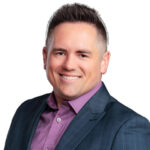 Dr. McCann attended Western University and Nova Southeastern University where he earned three Honours Bachelor of Science degrees, an accelerated MBA, and Doctorate of Optometry.
Dr. McCann attended Western University and Nova Southeastern University where he earned three Honours Bachelor of Science degrees, an accelerated MBA, and Doctorate of Optometry.
Dr. McCann owns twelve practices in Southwestern Ontario. He has been on the faculty at the Canadian Dry Eye Summit, The Myopia Meeting, and Myopia Summit to name a few. He has also lectured at hundreds of other events/conferences and across various platforms on contact lenses, ocular disease, dry eye disease, pharmaceuticals, and medical equipment. He is a KOL/consultant and/or speaks for companies such as Johnson & Johnson, Bausch & Lomb pharmaceutical division, Labtician, Thea, Oculus, Clarion, Zeiss, Otto, Luminus, Neurolens, Nikon and Sun Pharma. He has enjoyed, in the past, teaching clinical externs from the Waterloo School of Optometry, has served on the Board of Directors for the Ontario Association of Optometrists from 2016-2018, and is currently on the Board of Directors for Eye Recommend as well as a Director on the College of Optometrists of Ontario. He has been published in numerous journals including Review of Optometry and Review of Myopia Management.
In 2017, he was a recipient of the Top 20 Under 40 Award that is awarded to 20 individuals under the age of 40 recognized for their business achievements and community involvement in London Ontario. In 2024 he was awarded the Contact Lens Institute Award for Contact Lens Culture, recognizing his impact on fostering contact lens cultures that enhance patient experiences and business success.
